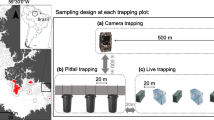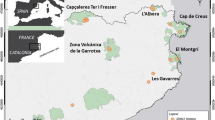Abstract
Maximizing cost-efficiency of biological surveys is of great importance to assess threats and monitor changes in tropical landscapes, particularly when survey costs are high as in Neotropical small mammals. Species detectability is mostly affected by local abundance but can further vary according to the forest size in fragmented landscapes. For example, species detection in smaller fragments may be higher due to either spatial constrains or forest vertical compression. Here, trade-offs between duration of trapping sessions and the cost of obtaining accurate small mammal individual and species data are investigated across a range of forest sizes, while accounting for potential sampling bias. Using a combination of live (Sherman and wire mesh) and pitfall traps, patterns of cumulative capture–recapture rates and community composition were examined across 16 night trapping sessions in 42 transects nested within 14 insular forest fragments of different sizes, and two continuous forest sites in the Central Brazilian Amazon. Based on 40,254 trap-nights, 604 captures were recorded from 22 identifiable species. Cumulative number of captures gradually increased along the entire trapping session, and on average, nearly half of all species required more than eight trapping nights to be detected at each sampling transect. Sampling bias was responsible for increased cumulative recapture rates in smaller fragments, but did not affect cumulative capture rates, or time to first detection of each species. Instead, time to first detection was mostly positively affected by species abundance. Our results highlight the higher effectiveness of long trapping sessions (i.e. > 10 nights) to detect uncommon species, increase sample sizes and recapture rates. Overall, if small mammal species abundance is high, sampling intensity can be reduced. However, regardless of species abundance, large fragments and continuous forest sites should be more intensively sampled to reduce any potential sampling bias.





Similar content being viewed by others
References
Adler GH, Seamon JO (1996) Distribution of four-eyed opossum, Philander opossum (Marsupialia, Didelphidae) on small islands In Panama. Mammalia 60:91–100. https://doi.org/10.1515/mamm.1996.60.1.91
Bolker BM, Brooks ME, Clark CJ, Geange SW, Poulsen JR, Stevens MHH, White JSS (2009) Generalized linear mixed models: a practical guide for ecology and evolution. Trends Ecol Evol 24:127–135. https://doi.org/10.1016/j.tree.2008.10.008
Borges-Matos C, Aragón S, Silva MNF, Fortin MJ, Magnusson WE (2016) Importance of the matrix in determining small-mammal assemblages in an Amazonian forest-savanna mosaic. Biol Conserv 204:417–425. https://doi.org/10.1016/j.biocon.2016.10.037
Bovendorp RS, McCleery RA, Galetti M (2017) Optimising sampling methods for small mammal communities in Neotropical rainforests. Mamm Rev 47:148–158. https://doi.org/10.1111/mam.12088
Brennan JM, Bender DJ, Contreras TA, Fahrig E (2002) Chapter 3: Focal patch landscape studies for wildlife management: optimizing sampling effort across scales. In: Jianguo L, Taylor WW (eds) Integrating landscape ecology into natural resource management. Cambridge University Press, Cambridge, pp 68–83
Canty A, Ripley B (2017) Package ‘boot’. https://cran.r-project.org/web/packages/boot/boot.pdf. Accessed 20 June 2018.
Carvalho FMV, Fernandez FAS, Nessimian JL (2005) Food habits of sympatric opossums coexisting in small Atlantic Forest fragments in Brazil. Mamm Biol 70:366–375. https://doi.org/10.1016/j.mambio.2005.08.003
Cleary D (2006) The questionable effectiveness of science spending by international conservation organisations in the tropics. Conserv Biol 20:733–738. https://doi.org/10.1111/j.1523-1739.2006.00413.x
Delciellos AC, Vieira MV, Grelle CE, Cobra P, Cerqueira R (2015) Habitat quality versus spatial variables as determinants of small mammal assemblages in Atlantic Forest fragments. J Mamm 97:253–265. https://doi.org/10.1093/jmammal/gyv175
Delciellos AC, Ribeiro SE, Vieira MV (2017) Habitat fragmentation effects on fine-scale movements and space use of an opossum in the Atlantic Forest. J Mamm 98:1129–1136. https://doi.org/10.1093/jmammal/gyx043
Devictor V, Julliard R, Jiguet F (2008) Distribution of specialist and generalist species along spatial gradients of habitat disturbance and fragmentation. Oikos 117:507–514. https://doi.org/10.1111/j.0030-1299.2008.16215.x
ESRI (2012) ArcMap 10.1. Environmental Systems Research Institute, Inc., Redlands
Ewers RM, Didham RK (2006) Confounding factors in the detection of species responses to habitat fragmentation. Biol Rev 81:117–142. https://doi.org/10.1017/S1464793105006949
Fahrig L (2013) Rethinking patch size and isolation effects: the habitat amount hypothesis. J Biogeograph 40(9):1649–1663
Fonseca GA, Robinson JG (1990) Forest size and structure: competitive and predatory effects on small mammal communities. Biol Conserv 53:265–294. https://doi.org/10.1016/0006-3207(90)90097-9
FUNCATE, INPE, ANEEL (2000) Mapeamento por satélite das áreas inundadas por reservatórios de hidrelétricas brasileiras. Unpublished Report. Convênio FUNCATE/INPE/ANEEL, São Paulo
Galetti M, Guevara R, Galbiati LA, Neves CL, Rodarte RR, Mendes CP (2015) Seed predation by rodents and implications for plant recruitment in defaunated Atlantic forests. Biotropica 47:521–525. https://doi.org/10.1111/btp.12246
Gardner TA, Barlow J, Araujo IS, Ávila-Pires TCS, Bonaldo AB, Costa JE, Espósito MC, Ferreira LV, Hawes J, Hermandez MI, Hoogmoed M, Leite RN, Lo-Man-Hung NF, Malcolm JR, Martins MB, Mestre LAM, Miranda-Santos R, Nunes-Gutjahr A, Oveal WL, Parry LTW, Peters SL, Ribeiro-Júnior MA, Silva MNF, Silva-Motta C, Peres CA (2008) The cost-effectiveness of biodiversity surveys in tropical forests. Ecol Lett 11:139–150. https://doi.org/10.1111/j.1461-0248.2007.01133.x
Glanz WE (1990) Neotropical mammal densities: how unusual is the community on Barro Colorado Island, Panama. In: Gentry AH (ed) Four neotropical rainforests. Yale University Press, New Haven, pp 287–313
Green RH, Young RC (1993) Sampling to detect rare species. Ecol Appl 3:351–356. https://doi.org/10.2307/1941837
Grelle CEV (2003) Forest structure and vertical stratification of small mammals in a secondary Atlantic forest, southeastern Brazil. Stud Neotrop Fauna Environ 38:81–85. https://doi.org/10.1076/snfe.38.2.81.15926
Gu W, Swihart RK (2004) Absent or undetected? Effects of non-detection of species occurrence on wildlife–habitat models. Biol Conserv 116:195–203. https://doi.org/10.1016/S0006-3207(03)00190-3
Haila Y (2002) A conceptual genealogy of fragmentation research: from island biogeography to landscape ecology. Ecol Appl 12:321–334. https://doi.org/10.1890/1051-0761(2002)012[0321:ACGOFR]2.0.CO;2
IBAMA (1997) Plano de manejo fase 1: Reserva Biológica do Uatumã. Eletronorte Ibama. Brasília/DF. https://www.icmbio.gov.br/portal/images/stories/docsplanos-de-manejo/rebio_uatuma_pm.pdf. Accessed 10 Sep 2017
Jones KE et al (2009) PanTHERIA: a species-level database of life history, ecology, and geography of extant and recently extinct mammals. Ecology 90:2648. https://doi.org/10.1890/08-1494.1
Lambert TD, Malcolm JR, Zimmerman BL (2005) Variation in small mammal species richness by trap height and trap type in southeastern Amazonia. J Mamm 86:982–990. https://doi.org/10.1644/1545-1542(2005)86[982:VISMSR]2.0.CO;2
Lambert TD, Malcolm JR, Zimmerman BL (2006) Amazonian small mammal abundances in relation to habitat structure and resource abundance. J Mamm 87:766–776. https://doi.org/10.1644/05-MAMM-A-261R1.1
Larsen TH (2016) Core standardized methods for rapid biological field assessment. Conservation International, Arlington
Laurance WF (1992) Abundance estimates of small mammals in Australian tropical rainforest: a comparison of four trapping methods. Wildl Res 19:651–655. https://doi.org/10.1071/WR9920651
Lira PK, Fernandez FAS, Carlos HSA, Curzio PL (2007) Use of a fragmented landscape by three species of opossum in south-eastern Brazil. J Trop Ecol 23:427–435. https://doi.org/10.1017/S0266467407004142
Mesquita AO, Passamani M (2012) Composition and abundance of small mammal communities in forest fragments and vegetation corridors in Southern Minas Gerais, Brazil. Rev Biol Trop 60:1335–1343
Moura MC, Grelle CEV, Bergallo HG (2008) How does sampling protocol affect the richness and abundance of small mammals recorded in tropical forest? An example from the Atlantic Forest, Brazil. Neotrop Biol Cons 3:51–58
Palmeirim AF, Benchimol M, Vieira MV, Peres CA (2018) Small mammal responses to Amazonian forest islands are modulated by their forest dependence. Oecologia 187:191–204. https://doi.org/10.1007/s00442-018-4114-6
Palmeirim AF, Benchimol M, Peres CA, Vieira MV (2019) Moving forward on the sampling efficiency of neotropical small mammals: insights from pitfall and camera trapping over traditional live trapping. Mamm Res. https://doi.org/10.1007/s13364-019-00429-2
Pardini R, Souza SM, Braga-Neto R, Metzger JP (2005) The role of forest structure, fragment size and corridors in maintaining small mammal abundance and diversity in an Atlantic forest landscape. Biol Conserv 124:253–266. https://doi.org/10.1016/j.biocon.2005.01.033
Pardini R, Faria D, Accacio GM, Laps RR, Mariano-Neto E, Paciencia ML, Dixo M, Baumgarten J (2009) The challenge of maintaining Atlantic forest biodiversity: a multi-taxa conservation assessment of specialist and generalist species in an agro-forestry mosaic in southern Bahia. Biol Conserv 142:1178–1190. https://doi.org/10.1016/j.biocon.2009.02.010
Pires AS, Lira PK, Fernandez FAS, Schittini GM, Oliveira LC (2002) Frequency of movements of small mammals among Atlantic Coastal Forest fragments in Brazil. Biol Conserv 108:229–237. https://doi.org/10.1016/S0006-3207(02)00109-X
R Development Core Team (2017) A Language and Environment for Statistical Computing. R Foundation for Statistical Computing, Austria
Rönnegård L, Alam M, Shen X (2010) The hglm package (Version 2.0). https://cran.r-project.org/web/packages/hglm/hglm.pdf. Accessed 20 June 2018.
Santos-Filho MD, Peres CA, Da Silva DJ, Sanaiotti TM (2012) Habitat patch and matrix effects on small-mammal persistence in Amazonian forest fragments. Biodivers Conserv 21:1127–1147. https://doi.org/10.1007/s10531-012-0248-8
Santos-Filho MD, Lázari PRD, Sousa CPFD, Canale GR (2015) Trap efficiency evaluation for small mammals in the southern Amazon. Acta Amaz 45:187–194. https://doi.org/10.1590/1809-4392201401953
Schoereder JH, Galbiati C, Ribas CR, Sobrinho TG, Sperber CF, De Souza O, Lopes-Andrade C (2004) Should we use proportional sampling for species—area studies? J Biogeogr 31:1219–1226. https://doi.org/10.1111/j.1365-2699.2004.01113.x
Sikes RS (2016) 2016 Guidelines of the American Society of Mammalogists for the use of wild mammals in research and education. J Mamm 97:663–688. https://doi.org/10.1093/jmammal/gyw098
Terborgh J, Lopez L, Nuñes PV, Rao M, Shahabuddin G, Orihuela G, Riveros M, Ascanio R, Adler GH, Lambert TD, Balbas L (2001) Ecological meltdown in predator-free forest fragments. Science 294:1923–1926. https://doi.org/10.1126/science.1064397
Terborgh J, Lopez L, Tello S (1997) Bird communities in transition: the Lago Guri islands. Ecology 78:1494–1501. https://doi.org/10.1890/0012-9658(1997)078[1494:BCITTL]2.0.CO;2
Umetsu F, Naxara L, Pardini R (2006) Evaluating the efficiency of pitfall traps for sampling small mammals in the Neotropics. J Mamm 87:757–765. https://doi.org/10.1644/05-MAMM-A-285R2.1
Vieira ALM, Pires AS, Nunes-Freitas AF, Oliveira NM, Resende AS, Campello EFC (2014) Efficiency of small mammal trapping in an Atlantic Forest fragmented landscape: the effects of trap type and position, seasonality and habitat. Braz J Biol 74:538–544. https://doi.org/10.1590/bjb.2014.0075
Vieira MV, Olifiers N, Delciellos AC, Antunes VZ, Bernardo LR, Grelle CE, Cerqueira R (2009) Land use vs. fragment size and isolation as determinants of small mammal composition and richness in Atlantic Forest remnants. Biol Conserv 142:1191–1200. https://doi.org/10.1016/j.biocon.2009.02.006
Watling JI, Donnelly MA (2006) Fragments as islands: a synthesis of faunal responses to habitat patchiness. Conserv Biol 20:1016–1025. https://doi.org/10.1111/j.1523-1739.2006.00482.x
Williams BK, Conroy MJ, Nichols JD (2002) Analysis and management of animal populations. Academic, San Diego
Woodman N, Timm RM, Slade NA, Doonan TJ (1996) Comparison of traps and baits for censusing small mammals in Neotropical lowlands. J Mamm 77:274–281. https://doi.org/10.2307/1382728
Acknowledgements
We thank all 15 volunteers/field assistants who assisted in the field; the Reserva Biológica do Uatumã and its staff for logistical support; M.N.F. da Silva for help with species identification. This study was funded by the Amazon Region Protected Areas Program (ARPA); Amazonas Distribuidora de Energia S.A.; Associação Comunidade Waimiri Atroari; Rufford Foundation (Grant number 13,675-1); Idea Wild. AFP was funded by Coordenação de Aperfeiçoamento de Pessoal de Nível Superior (CAPES) scholarship; MVV was funded by Fundação de Amparo à Pesquisa do Estado do Rio de Janeiro (FAPERJ CNE 201.344/2014) and Conselho Nacional de Desenvolvimento Científico e Tecnológico (CNPq Grant 308.974/2015-8).
Author information
Authors and Affiliations
Corresponding author
Additional information
Publisher's Note
Springer Nature remains neutral with regard to jurisdictional claims in published maps and institutional affiliations.
Handling editor: Heiko Rödel.
Electronic supplementary material
Below is the link to the electronic supplementary material.
Rights and permissions
About this article
Cite this article
Palmeirim, A.F., Peres, C.A. & Vieira, M.V. Optimizing small mammal surveys in Neotropical fragmented landscapes while accounting for potential sampling bias. Mamm Biol 100, 81–90 (2020). https://doi.org/10.1007/s42991-020-00012-2
Received:
Accepted:
Published:
Issue Date:
DOI: https://doi.org/10.1007/s42991-020-00012-2




